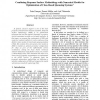Free Online Productivity Tools
i2Speak
i2Symbol
i2OCR
iTex2Img
iWeb2Print
iWeb2Shot
i2Type
iPdf2Split
iPdf2Merge
i2Bopomofo
i2Arabic
i2Style
i2Image
i2PDF
iLatex2Rtf
Sci2ools
DSN
2005
IEEE
2005
IEEE
Combining Response Surface Methodology with Numerical Models for Optimization of Class-Based Queueing Systems
In general, decision support is one of the main purposes of model-based analysis of systems. Response surface methodology (RSM) is an optimization technique that has been applied frequently in practice, but few automated variants are currently available. In this paper, we propose the combination of RSM with numerical analysis methods to solve continuous time Markov chain models of class-based queueing systems (CBQ). We consider first- and second-order models in RSM to identify an optimal parameter configuration for CBQ as part of the differentiated service architecture. Among the many known numerical solution methods for large Markov chains, we consider a Gauss-Seidel solver with relaxation that relies on a hierarchical Kronecker representation as implemented in the APNN Toolbox. To effectively apply the proposed optimization methodology we determine a suitable configuration of RSM and compare the results with previous results for optimizing CBQ.
Computer Networks | Continuous Time Markov Chain | DSN 2005 | Markov Chains | Response Surface Methodology |
| Added | 14 Oct 2010 |
| Updated | 14 Oct 2010 |
| Type | Conference |
| Year | 2005 |
| Where | DSN |
| Authors | Peter Kemper, Dennis Müller, Axel Thümmler |
Comments (0)

